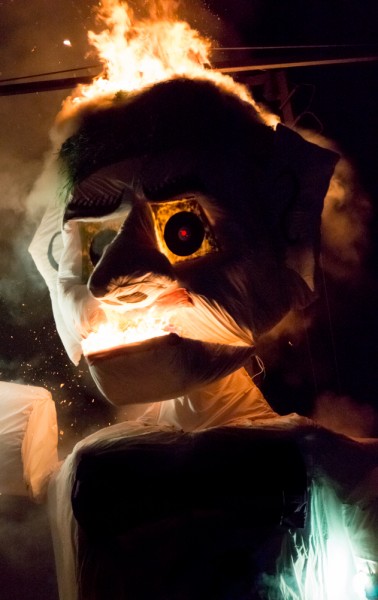Tags
Related Posts
Share This
The Meaning of Gloom
When I arrived at Fort Marcy Park, I had no idea what to expect. The air was filled with the scent of fair food: funnel cakes, turkey legs and various other carts spewing out New Mexican favorites. The mood was reserved, and there were still a number of hours before the actual ritual was set to begin and the crowd was not quite filled out.
I was unimpressed. There was little difference between this and something like a county fair—except a fair would have booths and rides to entertain. Was this the Zozobra everyone was talking about?
This was my first burn and I wasn’t feeling it. After my arrival I drifted over to the official “Gloom Box,” the place for people to write down their worries, stuff them in a box, then have them put into a giant puppet. I scrawled my most dominant worry (I didn’t want to spread the magic over several worries) onto a small slip of paper, folded it, then tucked it into the gloom box. A sticker of triumph was passed my way—the word “gloom” in black letters, crossed out with a red line and circle.
I kept an eye and ear turned towards the gloom box. There was something about it. Orderly queues formed. People posed for photos after filling the box with their lamentations.
Parents instructed their children on the procedure, letting the kids write out their own worries, then hoisted them so they could push the paper into the box themselves. My initial reaction to the ritual was that people were using Zozobra as a scapegoat. That they were pushing off responsibilities onto this victim, but it was more than that. They drank in the ritual some had participated in for generations, conjuring up what troubled them the most and eagerly anticipating the point where their worries would be lifted from them. Immediate relief settled on the faces of some individuals. They left the box and broke into tears, rushing to the consoling arms of friends and family.
Then came the point where the box was taken to Zozobra for drop-off. Some people missed the deadline. One man approached me, asking if this was the location of the gloom box. I informed him it had been taken.
“Man, I just got divorced. You mean I have to wait until next year to get rid of this?”
I thought, couldn’t you just burn it all yourself? He couldn’t. It wouldn’t be the same. I began to realize what the event meant to people.
Then, the lights went out. The cheers from the crowd were met by music from the PA system. “Gloomies,” children dressed in white with outstretched wings, fluttered into view. The music lilted as the small figures drifted around the base of Zozobra, before darting out of sight. The music began to pound as hooded figures raced onto the scene bearing torches. Zozobra moaned and thrashed more vigorously. The torchbearers thrust their fiery brands at him before a figure clad in crimson appeared. The torchbearers exited while the dancer gyrated and did a pagan Fred Astaire impersonation. I overheard from nearby that each step on the stairs is a choreographed part of the ritual, unchanged in nearly 90 years.
The moaning continued as the dancer brought a torch up the steps. Fireworks mingled with the cries of Zozobra as the embodiment of sorrow went aflame. The moans turned more pitiful, nearing pained shrieks. Zozobra’s clapping mouth glowed with fire until his head was engulfed.
The moaning stopped.
The effigy spiralled with roaring flame, until the heat and scent met me hundreds of yards away.
The emotion of it it all, evident in the cries from the crowd, was the surge of knowing that the wind carried away their worries.







 Jackalope Magazine is the student magazine of Santa Fe University of Art and Design. Building on the interdisciplinary nature of our education, we aim to showcase the talent of our university and character of our city.
Jackalope Magazine is the student magazine of Santa Fe University of Art and Design. Building on the interdisciplinary nature of our education, we aim to showcase the talent of our university and character of our city.
Recent Comments